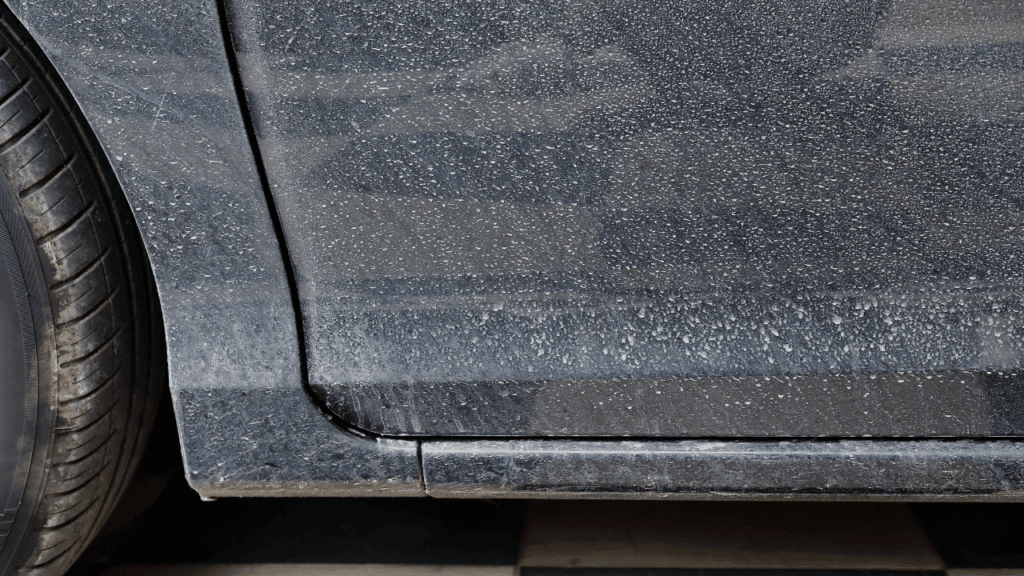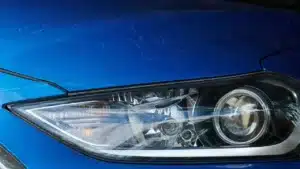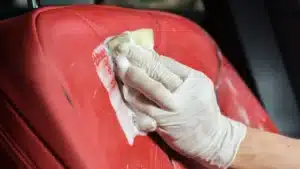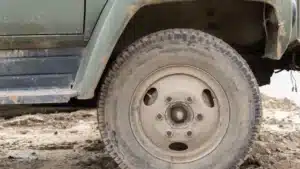You always want your car to look shiny. Unfortunately, even if you wash it regularly, hard water spots can make the exterior look dirty. Car wash facilities may use hard water, and the rain contains minerals that dry on your car after the liquid evaporates. This problem can be especially noticeable if you have a black car.
You can’t avoid the rain, and you still need to wash your car if you want it to have any chance of looking shiny and clean. Therefore, you need to find a technique for removing water stains. Because you will have to do it often, you will want methods that are quick and convenient and use materials that are easy to get.
Here is a look at how to remove water spots from car paint and windows. Read more about how to remove stains from car paint

What are Hard Water Spots?
Hard water stains do not actually come from the water itself. Instead, the droplets contain minerals. This residue stays on the surface of your car after the water itself evaporates or drips off.
Many water utility companies also use chemicals or additives to make the water safe for drinking and using to wash your body. These added substances can also leave a residue on surfaces.
Hard water is especially noticeable on shiny exteriors. If you have hard water in your home, you’ll likely see spots on your glasses or plates after they go through the dishwasher. Since it has glossy surfaces, your car is also a prime target for hard water stains.
Hard water stains are a cosmetic issue. However, if you don’t remove them in a timely manner, they can cause more permanent damage to your auto.
How Long Does It Take for Water Spots to Damage Car Paint?
Water spots may seem like a nuisance rather than a significant problem. If you are not planning to drive for a while, you may decide to simply leave the stains on your car. However, if you wait long enough, the minerals and chemicals could cause lasting damage to your paint.
Minerals are corrosive, and they can cause a problem called “etching.” Etching occurs when the mineral wears away the clear coat on your car and reaches the paint. Not only can this lead to permanent spots, but it can also create small divots that catch additional water drops, compounding the problem.
Etching can take place quickly. If the weather is hot and sunny, and you have a dark-colored or black car, etching can happen in a day or less. If the vehicle is not exposed to harsh sunlight or heat, etching may take several days. You definitely do not want to leave water spots on your car for more than three days, even if you park it out of the sun in a garage.
How to Remove Water Spots from Your Car?
You can rely on various water spot removers to get stains off your car paint and windows. The good news is that some methods call for ingredients you probably already have around the house. For example, you can remove water spots from car with vinegar.
Of course, whether you are using ingredients from around your home or a store-bought product specifically for removing hard water spots, you need to use the correct technique. If you use the wrong mixture, leave it on your car for too long, or scrub it with an abrasive material, you will damage the paint or glass.
Here are effective techniques to remove water stains from car glass or paint. We will also share the details of each method so that you can perform the cleaning correctly and avoid damaging your car during the job.
What Materials Do You Need?
Before you learn how to remove water spots from car paint and glass, you need to get the right materials. There are four different types of things you might need for this project: water spot removers, scrubbing tools, washing and rinsing materials, and, if necessary, safety gear.
- Water spot removers can include household products like vinegar, baking soda, detergent, or isopropyl alcohol. You can also try store-bought products specifically for removing water stains.
- You also need to get the right scrubbing tools. You can use a wide variety of implements, but you should never use abrasive materials that could scratch the paint or glass. Microfiber cloths, towels, sponges, and nylon brushes are preferable. You can also use special products like auto detailing clay. Some methods call for very fine steel wool, which can erase stubborn spots. However, this only works if you use the finest grade (#0000 steel wool).
- Post-treatment washing and drying are often necessary. Some substances for removing water stains will damage the car if left on the surface for too long. You’ll need clean water to rinse the car and extra towels to dry it to keep new water spots from forming.
- Some substances that remove water stains from car glass or paint are not toxic, but others, such as products that contain ammonia, can be dangerous if they get into your mouth or lungs. If you use these stain removers, you should consider wearing gloves, a face covering, and safety glasses.
Once you have collected the necessary materials, it’s time to start learning how to remove water spots from car paint and glass.
Here is a look at the methods you can try.
1. Car Washing Detergent
You may be able to rewash your car using regular car soap to remove water stains that haven’t been there for too long.
Here’s what you need for this method:
- Car wash soap or detergent.
- A sponge or microfiber cloth.
- A hose.
- A bucket for the soap mixture.
You can park your car outside on the street or in the driveway when you are ready to start.
- Mix the soap with water in the bucket.
- Using a sponge or cloth, scrub the car, paying special attention to the areas with water spots.
- Rinse the exterior with the hose.
- Dry the surfaces with a clean towel to avoid more water spots.
You might also consider a water filter for your hose. These filters can remove some of the minerals to lower the danger of new hard water spots forming after the wash.
2. Detailing Clay or Steel Wool
If a standard wash isn’t enough, you can use stronger scrubbing tools to try to remove the water stains. Detailing clay and steel wool are two options for this. Here is what you need for this method.
- Detailing clay, which is available at auto parts stores.
- Fine steel wool. You need grade #0000. Other grades will leave scratches on the paint.
Once you have your chosen tool, you can start the process.
- Use a lubricant. Water or soap is fine. You can also use another cleaning agent if you wish.
- Scrub the stubborn water stain with a light circular motion. It’s better to use a repeated motion than to press down too hard.
- Rinse and dry the surface once the stain is removed.
The advantage of these tools is that you can keep them and use them again and again.
3. Vinegar
It’s possible to remove water spots from car with vinegar. The natural acidity will wash the mineral deposits away. However, it’s important to follow the right procedure when using this method to avoid damaging the paint.
Here’s what you need to get started.
- Vinegar.
- Water.
- A spray bottle.
- A cloth.
Here is the method for this convenient option for removing water stains from your car.
- Create a mixture with one part vinegar and three parts water. Distilled or filtered water works best.
- Put the mixture in a spray bottle.
- Spray it on the water stains and let it sit for a few seconds.
- Scrub the spots using a cloth. Continue until the spots disappear.
- Rinse and dry the surface.
If there are stubborn spots, you can use pure vinegar directly on a cloth to scrub them.
4. Baking Soda
Baking soda can break up and dissolve mineral and chemical deposits. Here are the materials for this method.
- Baking soda.
- A bowel or bucket.
- Water.
- A brush or cloth.
Once you have the necessary materials, you can start making a paste and applying it to the hard water stains.
- You can make a paste with one part water and two parts baking soda.
- Stir the mixture thoroughly and apply it to the stains.
- Let the mixture sit for a while, then scrub it using the brush.
- The spots should eventually disappear. When they do, you can rinse and dry the surface.
Baking soda can also work to get water stains out of car seats.
5. Isopropyl Alcohol
Isopropyl alcohol, at either 70% or 91%, can remove minerals from surfaces. It is an option for especially-stubborn spots.
You’ll need the following:
- Isopropyl alcohol. A 70% mixture is usually strong enough.
- A cloth.
Isopropyl alcohol is strong, so you might want to wear gloves when using this method. Once you have a pair, you can get started.
- Put the alcohol on a cloth. You shouldn’t pour the liquid directly on the car.
- Scrub the water stains. A circular motion works best.
- Once the stains are gone, you can rinse and dry the surface. Make sure you rinse thoroughly to remove all the alcohol residue.
You do not want to leave alcohol on the car because it will eventually damage the clear coat and paint.
6. Store-Bought Spot Removers
There are many cleaners made especially for removing water spots and residue from car bodies. Here is what you need if you want to try this option.
- A cleaning product. Auto parts shops and big-box stores will have a few options.
- A cloth, sponge, or brush.
- Safety gear. If the cleaner has certain substances, such as ammonia, you will want gloves and a mask to ensure you remain safe while handling the product.
The methods for these cleaners differ.
- Follow the directions on the product container. The process usually involves applying the cleaner to the stains before scrubbing and rinsing.
These cleaners are an option if the more convenient choices don’t succeed in removing the water stain.
How to Remove Water Spots from Plastic Trim?
It is safe to use natural methods to remove water spots from the plastic components on your car’s exterior. The vinegar solution, baking soda paste, or car soap methods will work on plastic without damaging it.
However, like metal components, you will want to rinse and dry the plastic trim afterward to remove any residue and ensure that new water spots don’t form.
Some store-bought spot removers will also work on plastic. To be on the safe side, you should only use products that specifically say that they are safe to use on plastic trim. Depending on the composition of the plastic parts, some cleaning agents, like ammonia, may cause damage or strip off the exterior layer.
How to Prevent Water Spots on Car Surfaces?
You can’t avoid rain or cash washes, so you are always going to have to deal with water spots. However, some products and methods can help you limit the problem.
First, you can dry your car after it rains or use a carwash with workers who will manually dry the vehicle. This will limit the residue that builds up when the water evaporates.
The second method is to use a specialized product like Rain-X or a similar water-repellant or wax application. These liquids harden to create a smooth surface that allows the water to run off before it dries. Because it drips off the car immediately, it does have time to leave the mineral deposit behind.
FAQ
Will rubbing compound remove water spots?
If you use a fine rubbing compound and ensure the car is completely free from dirt and road grit, you can successfully remove challenging water spots without scratching the surface. Like other similar methods, like steel wool, you need to use soap or water as a lubricant. You should also rinse and dry the surface after you’re done with the job.
Does wax remove water spots?
Liquid wax can remove water spots if you rub it thoroughly into the car. Wax products can also help liquid run off the vehicle before it settles and evaporates. For this preventative measure to work, however, you need to apply wax regularly. If you are willing to commit to doing this, you can stop most hard water stains before they start.
Does vinegar hurt car paint?
Vinegar is acidic, and it can damage car paint. However, its acidity is relatively low, so it would have to remain on the surface for hours before damaging it. This is why our method to remove water spots from car with vinegar requires you to rinse the surface. If you rinse off all the vinegar, there is no need to worry about permanent damage.
Are water spots on your car permanent?
If you catch water spots early enough, they are not permanent. However, if you leave the mineral deposits on the paint or glass for too long, they will eat into the clear coat, creating permanent damage. That is why it’s so important to deal with water spots quickly once you notice them.
Does WD-40 remove water spots on car bodies?
The all-purpose lubricant WD-40 can remove water spots on car metal and glass. It reacts with the mineral deposits, loosening them and making it easier to wipe them off with a towel or cloth.
Related Content:



